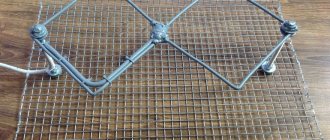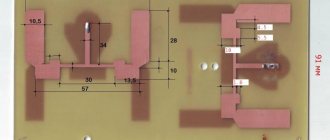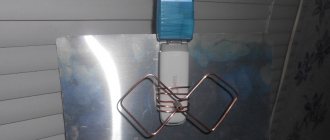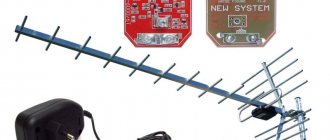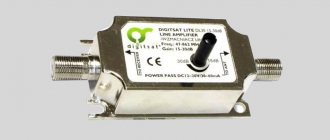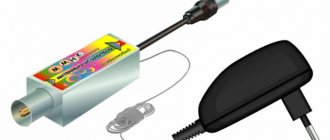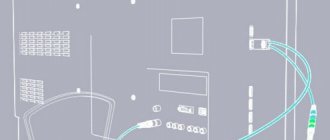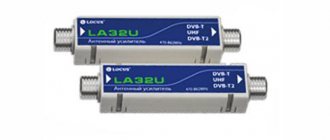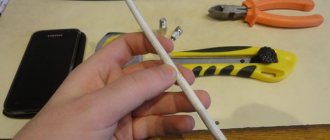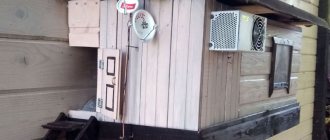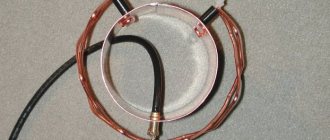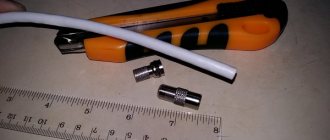The popularity of the Internet among the population is constantly growing. However, many people live in places where the signal is very weak or non-existent. In this regard, the problem of increasing the power and quality of Internet reception becomes very acute. Slow speed takes a lot of time and does not give the desired result. Therefore, an external Kharchenko antenna often comes to the rescue, designed in the form of a double square, the material for which is thick copper wire. The connection with a square to each other occurs in places of open corners, where the television cable is connected.
Such an antenna requires precise calculations for digital terrestrial television. To improve directionality, some designs may include a grating or continuous screen made of conductive material. Such a biquad antenna allows you to solve many problems with signal reception and Internet speed. Homemade structures, including various types of Kharchenko antennas, are relatively easy to make and include metal and plastic parts, as well as elements from other materials, connected in different ways. Similar designs can be easily made independently, including the Kharchenko antenna for TV with your own hands.
Cutting files with administrator rights
To say goodbye to unnecessary information, you can also use administrator rights. For this:
- First, enter cmd into the search bar of the Start button.
- Secondly, right-click on the result obtained and select the line “Run as administrator”.
- Thirdly, in the window that appears, enter the command oppwiz.cpl and press the “Enter” button.
- After these steps, the “Uninstall or change a program” window will open, where you can find the desired program. And delete it by clicking the appropriate button.
Depending on the connection method
SMA modification
Several conditions must be met for this modification of the antenna for a 4G router to work for the user:
- 3G/4G modems equipped with TS-9, CRC-9 connectors.
- Models with SMA connectors through which external connections are organized. The modem is already built into these routers. All you have to do is insert the SIM card.
- You will need not only the device itself, but also 2 cable assemblies with SMA connectors, up to 10 meters long. Then it’s easy to enhance the signal quality.
- To connect the cable, it is recommended to purchase two special adapters or pigtails.
Note! The use of this technology is relevant if there are connectors where external devices are connected. You can also use adapters to connect to regular USB modems
But a high-frequency cable in such situations will be too expensive. And losses in signal quality will remain serious. We'll have to strengthen
You can also use adapters to connect to regular USB modems. But a high-frequency cable in such situations will be too expensive. And losses in signal quality will remain serious. We'll have to strengthen it.
BOX modification
The purchase of such products requires the presence of the following equipment:
- USB extension cable.
- Modems for outdoor antennas for 4G modems, supplemented with TS-9, CRC-9 connectors.
Important. At the rear, the device is complemented by a sealed box of small dimensions
Adapters for connecting to a modem are usually already built into this part. A modem with 3G/4G technology is installed inside the box, to the connectors of which adapters are then connected. The next step is to insert a USB extension cable into the box. Usually a special sealed lead-in is used. All that remains is to connect to the modem.
A universal WiFi router with a USB connector and 4G support is needed if you plan to use the Internet on several devices simultaneously.
If the user already has a 3G/4g modem, the BOX modification will be an excellent way to save money. Only the modem limits support from certain telecom operators. The overall stability of operation via a USB extension cable largely depends on specific models.
USB modification
This is a kind of ready-made complex that allows you to amplify signals that are transmitted according to conventional standards. The user does not need any additional devices; a standard set is sufficient for amplification.
Note. A universal 4G modem is already built inside from the start
But 3G standards are also supported. It is enough to connect a SIM card from any operator operating in Russia. After this, the device is connected to the computer. Another option is to use a router together with a USB cable 10 meters or more long.
Signal loss on cables when using USB modifications is completely eliminated, the connection is stable.
Note! Only Ethernet modification devices will be a suitable solution if the connection requires a cable longer than 10 meters
Ethernet modification
Another type of ready-made kits that amplify the signal for modern 3G/4G standards. The kit comes with a built-in 4G modem, which is complemented by a router with a POE adapter. This designation is a technology that allows you to connect regular Ethernet cables. Their length, at the user’s request, can reach 100 meters.
When the connection freezes, the device supports automatic rebooting. Characterized by compatibility with WiFi routers of almost any modification. The rating will help you make your choice.
Note! Signal loss on cables is almost completely eliminated, which already distinguishes this option from the SMA 4G antenna
Kharchenko antenna: how to make and principle of operation
The Kharchenko antenna is one of the simplest antennas in design for 4G. It is named after the scientist-inventor.
Parts needed to create:
- wire;
- coaxial cable;
- wooden slats;
- pliers, hammer, knife.
After preparing the materials, it is necessary to calculate the antenna. To do this, there are special online calculators that make the work easier.
Assembly sequence:
- Determination of wave polarization and frequency. The device must be linear.
- Creation of a biquad antenna device in the form of a zigzag made of copper. All elements are located in the corners. For horizontal type polarization, the figure eight must stand upright. If you do vertical polarization, the structure lies on its side.
- Calculation of the side of a square using a special formula: wavelength divided by four.
- Creating an oval-shaped structure that should be pulled together in the center across the larger side. The sides do not touch, but are in close proximity to each other.
- Connecting the antenna cable to the approach points on both sides. It will be necessary to block one direction of the diagram, for which a fetal screen made of copper will be mounted; it will be located at a distance of 0.175 mm from the working wavelength. It should be placed on the cable braid.
Next, you need to test the antenna by connecting it to the modem.
Antennas for improving the quality of a mobile signal are different. They are sold in specialized stores and are easy to assemble with your own hands. In the second case, the quality of the Internet connection will not be worse, but will save money.
Communication range
The following factors influence the radio range:
- Location of BS and MS and terrain.
- MS power and sensitivity.
- Power and sensitivity BS.
- Antennas used on MS and BS.
- The will of the Lord God (experienced signalmen joke that this is the main thing).
Typically base stations have a power of 20 - 30 W. Antennas are used either whip or directional. The sensitivity of base stations is -100 dB - 115 dB. The user, of course, cannot change or influence all these parameters. The output power of the phone is 0.3 - 2 W, sensitivity - 90 - 105 dB. The sensitivity of a phone is mainly determined by the technologies used to create low noise input devices. If in areas of reliable reception the difference in sensitivity and power between models is almost unnoticeable, then in an area of uncertain reception it can become critical. Often the handset shows the signal level from the base station as 1 - 2 cubes (on the scale), but cannot establish a connection: there is not enough power. And although the ETSI standard regulates the standard output powers for each class of phone, the actual value may vary slightly. Tubes from SAGEM, Alcatel, and Motorola have good sensitivity. And all old phones pass in terms of power, especially Motorola. All phase 2 phones have approximately the same power.
As for the terrain, waves travel better on flat terrain and along the river. The higher you are (within reason), the better the signal. The forest sometimes dampens the waves more than urban buildings.
The first option is directional devices
When there is a signal on the 3G modem, but it is not strong enough, then you can get by with quite simple devices in order to achieve better quality of mobile Internet reception.
Typically, this measure consists of better positioning the modem and pointing its standard antenna in the desired direction (towards the tower). An ordinary tin can, an old pan, dishes, or even a simple disc may be suitable for these purposes.
For example, if we talk about a can antenna, then you only need to punch a hole at the base or in the bottom in which the modem itself would be securely attached. In fact, the signal should be significantly stronger if you choose the right direction.
An example of a homemade can antenna
Those who use old disks to amplify the signal do it even simpler. The main thing is that they are opaque. But you shouldn’t expect great achievements from this method.
If you need to make the signal a little better
No special engineering skills are required if you adapt old dishes to enhance signal reception. Colanders or saucepans with handles work especially well. Then you can attach a USB cable to the handle, and move the modem itself a little into the inside of the dish, something like this:
Another simple way to improve signal reception with a 3G modem
Description of a homemade receiver
With appropriate settings, this antenna is both an amplifier and a receiver. The inventor and scientist Kharchenko suggested using this biquadrat as an antenna. Biquadrat is a subspecies of loop antennas, which are primarily classified as zigzag.
K. P. Kharchenko proposed this device as an antenna in the middle of the last century (1961) for use as a television receiver. There is a good reason for this: it is a historical, recorded fact that, having tuned his antenna to a frequency of 14 megahertz and giving it the required position, the scientist received a signal from America.
Among the factory models of amplifier antennas, it is easy to find powerful devices with high performance. But quite often you can get by with a simple design that can be easily assembled from available materials with your own hands. It is enough to use the well-known development of Kharchenko.
According to the creator’s research, in terms of output parameters, the antenna reliably enhances the operation of digital devices operating on mobile platforms, generating an increase in signal reception of up to 3-4 dB, even without the use of a reflector, and with its implementation - up to 8-9.
DIY Kharchenko antenna for 3g modem
Modern society cannot imagine its existence without the Internet. This network provides many opportunities that all people want to use, but do not always have such an opportunity. It is at such moments that the idea arises of creating antennas that can pick up signals even in the most remote places.
Antennas for 3g are only effective when made correctly. Sometimes you can see a variety of options. But why complicate the situation if you can make a simple option that can guarantee the end result. For this purpose, the Kharchenko antenna was invented.
Type and contents of the Kharchenko antenna
This antenna has the form of square elements connected to each other. That is why it is also called a butterfly. The manufacturing process is very simple. The basis of the structure is a wire that needs to be bent and the ends soldered. In this case, an angle is formed between the walls of the Kharchenko antenna, which is equal to 120 degrees.
For proper operation of the device, other parameters must be met: the side wall must be 5.3 cm long. The junction of the squares is 2 points, the distance between which is 5 mm. Under no circumstances should this parameter be changed.
Manufacturing
The aluminum plate should be 0.2 cm thick. You can buy it or make it yourself. To do this, we align the plate and make it into a square with sides of 14 cm.
We measure the center in order to drill a hole in it into which the coaxial cable will be inserted. It will be positioned in such a way as to reach from the wire element to the modem.
The wire is attached parallel to the plate using special holders made of plastic or other materials that are not capable of conducting electricity.
The Kharchenko antenna for a 3g modem with your own hands will not work without a cable, which must be passed through a hole drilled in the plate. Next, we connect it to the points at the junction of the previously made squares. All that remains is to connect the second part of the cable to the modem, onto which you need to put a piece of copper foil, and then wrap it several times and solder it so that the foil does not come apart in any case. Afterwards, you need to make a braid that would subsequently not touch the central core, which is connected to the foil on the modem. At the last stage, you need to check the signal level. If it is quite strong and without interference, then the Kharchenko antenna is made correctly
Process of creation
The assembly steps will depend on what type of device has been selected.
Simple external device
A conventional external antenna is a device for enhancing the quality of a cellular network signal, which is installed outdoors. It can have a different appearance, for example, in the form of a large plate catcher or a simple television antenna adapted for a 3G signal.
Note! In the case of external antennas, the quality of insulation plays a big role, since the amplifier will have to work in different weather conditions.
It is important in such devices to choose the best location for installation and direction towards the base station. In addition, they should be properly insulated to prevent water from getting into areas with microcircuits and wire connections.
The reflector is created from a metal sheet, which is recommended to be rounded. If there is no steel, then you can use plywood or cardboard, which should be wrapped in foil.
Panel antenna
It is a large metal plate with patches or small panels attached to it for better capture. To create a 4G antenna - a “gun” - with your own hands you need to buy:
- ribbed galvanized iron to create a panel (one sheet with dimensions 334x290 mm);
- to create patches, four sheets of galvanized iron (dimensions 118x70.5 mm);
- copper wire (diameter 2 mm);
- copper foil, preferably several large pieces (cut a circle with a diameter of 21 mm);
- foam for patches;
- Super glue.
How to make an Internet amplifier with your own hands: diagrams
The cost of ready-made devices to improve the quality of the Internet connection is quite high. In this regard, a large number of users assemble amplifiers themselves at home. You can either convert a GSM repeater into 3G, or make it specifically for a network connection. But for this you will still have to purchase a ready-made repeater, since few people can make one from scratch.
Preparing for assembly
First you need to purchase parts and components of the structure:
- wire, the total length of which should be about 35 cm;
- a cable whose length depends on where the antenna will be installed. It is not recommended to buy more than 10m;
- connection block;
- fasteners for connecting several blocks together;
- plastic.
Note! Scotch tape or electrical tape is also useful for gluing parts together.
Creating an Antenna
The antenna is assembled as follows:
- You need to make a rhombus from the purchased wire. To do this, it must be bent in the middle at an angle of 90°. Then, at distances of 9 cm from the center, make two more 90° bends.
- Bend the ends inside the rhombus and connect the connecting block.
- Drill a hole in the polymer pipe.
- Using a coaxial cable, which has previously been stripped of insulation at the ends, connect the antenna. Connect the conductors, both external and internal, to the contacts of the connecting block so that the cable becomes an extension of the antenna.
- Installing the antenna on the roof and choosing the correct direction to the tower, testing the result.
Protection
To protect from external influences, the remote antenna must be placed in a housing of suitable dimensions. The exit points of the cable and fasteners must be carefully sealed.
Important! The body of the structure must be made of non-conductive material. It can be polystyrene or polyethylene
The first material is preferable because it allows the body to be assembled by gluing and is sufficiently resistant to ultraviolet rays, low and high temperatures.
External devices are at their greatest risk during a thunderstorm. A lightning strike that hits an antenna can instantly damage the internal circuits of all equipment connected to it. Therefore, if there is a possibility of a thunderstorm, you should disconnect the antenna cable from the modem or router connector.
Homemade devices for increasing the received signal power can improve the quality of reception, the speed of reception and data transmission, eliminating additional costs for more advanced equipment.
Antenna for 3g modem: DIY life hack
Many people in the modern world use the mobile Internet - with the help of it a person can communicate remotely, receive information and even work. But the provider does not always provide users with a stable connection speed due to the characteristics of communication reception, which may be limited by terrain features, a large distance to the transmitter, and other factors.
A homemade antenna for a 3g modem will help you improve the speed and range of signal reception. We offer you several instructions on how to make an antenna for a 3G modem with your own hands.
Kharchenko's method
We recently wrote how to make an antenna for television reception with your own hands. But did you know that you can make a homemade antenna for a 3G modem in a similar way?
We will need:
- Copper wire or wire, you will need a section of about 30 centimeters;
- Coaxial cable with a resistance of 50 or 75 Ohms;
- Connector for connecting the antenna to the modem;
- A piece of foil or DVD as a reflector;
- Tools: knife, soldering iron, pliers, glue, ruler and pencil;
- Plastic bottle cap to separate the antenna from the reflector.
Production of biquadrat Kharchenko
In photographs of homemade antennas for 3G modems you can see its approximate appearance. First, you need to make markings on the copper wire with a pencil: the length of the outer side of each square should be approximately 35-36 mm.
Carefully bend the wire along the markings, helping yourself with pliers. You should get a symmetrical design of two squares touching at the corners. Remove the remaining pieces of wire.
Make a hole in the cover and insert the end of the cable into it. Separate the cable, exposing the inner conductor and shield for soldering.
Insert the reflector disk into the wire through the hole, move it towards the antenna and glue it to the cover. Solder the connector to the cable on the other side for connecting to the modem. Connect the antenna to the modem. Enjoy the result of your work!
Double ring antenna
The next method of creating a homemade antenna is more difficult to implement, but gives a greater effect. To complete it you will need:
- Copper wire or wire;
- Reflector - a flat long tin can, a piece of foil, etc.;
- Coaxial cable with a resistance of 75 Ohms;
- A short metal tube into which a cable can be threaded;
- Connector for connecting the antenna to the modem;
- Tools: soldering iron, knife, ruler and pencil.
Detailed manufacturing instructions:
- Search on the Internet for a Bi-Loop antenna diagram for a 3g modem - on it you will see a design similar to the Kharchenko antenna, but in the form of two rings;
- Make markings on the wire with a pencil: for waves with a length of 2050 MHz, the length of each ring should be approximately 146 mm;
- Carefully bend the wire into a double ring. You can also make two rings with gaps approximately 3mm long and solder them end to end, leaving the gaps open;
- Make a reflector. Minimum dimensions: height - 120 mm, width - 170 mm. Any metal panel will do; you can use foil or tin from a tin can if you have available materials;
- Make a hole in the middle of the reflector through which to insert a metal tube - from the side connecting to the antenna, the length of the tube should be approximately 18 mm! Solder the tube to the reflector on the other side;
- Separate the cable with a knife: the screen should be soldered and the conductor should be slightly exposed;
- Thread the cable into the tube and solder the antenna to it: the upper part should be soldered to the conductor, and the lower part to the copper tube;
- Solder the tube and cable braid;
- Additionally, to strengthen the signal, you can use a satellite dish by installing a ready-made antenna on the bracket;
- The other end of the cable should be connected to the modem connector using a soldering iron;
- Connect the antenna to the modem. Ready!
Now you know several ways to make an antenna for a 3G modem with your own hands. The above methods should help you solve problems with low Internet connection speed.
Characteristics calculation
You can calculate the length of vibrators online: on the Internet you can find more than one specialized calculator that can calculate the final values with great accuracy. However, you can calculate the necessary characteristics using the formulas given below.
The size of the elements is calculated based on the frequency range in which it will operate. First, you will need to find out the frequency of electromagnetic radiation at which the channel of interest is broadcast on digital terrestrial television (DTTV). You can find it on the Internet. The type of polarization of the wave is also indicated there. This information is needed in order to know in which plane to place the assembled structure.
The main parameter that affects the quality of the signal received by the antenna is the length of electromagnetic radiation. It is denoted as lambda (λ) and is calculated using the broadcast frequency (F) using the formula: λ=300/F. The size of each conductor of a diamond-shaped cell is equal to a quarter of the wavelength - λ/4.
If the Kharchenko antenna is made with a reflector, then the distance between them is equal to λ/7. Also, the area of the metal plate chosen as the screen should be approximately 20% larger than the area of the biquadrates. The reflector area can be calculated using the formula: (2×a²)×1.2, where a is the length of the side of each conductor.
The calculation of parameters for the modem and telephone is similar to that given for digital television.
Types of antennas for 3G and 4G
At the moment, there are many types of signal receivers for third and fourth generation mobile networks. Many of them were used even before the advent of cellular communications (for television broadcasting) and managed to prove themselves well. Below we talk about the main antennas for 4G Internet, which you can assemble with your own hands.
Simple
The most primitive type of antenna, which looks like an ordinary piece of wire. This device is classified as medium- or low-power. That is, it is unlikely that it will be possible to maintain long links with its help. But you can easily replace the standard antenna of a router or modem with 2 decibels. This will allow you to at least double the coverage radius of your network device without much expense.
Antenna soldered to the modem
Panel
Another option for equipment used to improve signal quality. They are especially popular for working with 3G and 4G networks.
Note! Initially they were used for third-generation standards, but then it became clear that these devices can easily work with LTE networks. The thing is that the working range of these standards partially coincides
Directional 3G, 4G gun
This device is a pin on which copper circles of a fixed radius are placed at a certain distance. The advantage of such a device is that with a competent approach and a minimal amount of money spent, you can get an antenna that picks up a signal even 30 km from a tower or base station, which is extremely profitable and convenient.
MIMO
To increase the capacity of data transmission channels between the receiver and transmitter, a special method of processing radio signals was developed, based on the fact that transmission receptions are carried out through various antennas.
Important! By using a MIMO antenna, you can increase the network access throughput. This will be a value that is on average 10-30% greater than when using a simple antenna
The basic operating principle of the device is to eliminate any connections between the receiving and sending antennas.
Kharchenko antenna, or biquadrat
An antenna that was invented back in the 60s. last century, is rightfully considered one of the most popular. In those days, it helped improve the picture quality on TV for people living outside the area of reliable television reception, and today it can easily increase the speed of access to mobile networks and telecommunication systems.
For your information! Its other name is biquadrat.
Wave
An antenna called a “wave channel” was invented even earlier, in 1926 in Japan. These devices immediately became popular all over the world. They are very easy to manufacture and have fairly good directionality. The television has become digital, which means that the multiplex can transmit several channels at once on the same frequency.
Important! This has greatly simplified the manufacture of the antenna, since now there is no need to provide a broadband signal, it is enough to create a receiver for one specific frequency
Other possible types
One of the most common types of antennas is a satellite dish feed. It is sold in many specialist places and is good value for money. Satellite dishes allow you to record a signal at a distance of up to 40,000 km. It is clear that making such a device at home is extremely problematic, so it is not worth a detailed consideration. If you wish, you can simply buy it.
Operating principle of a signal amplifier
Receiving and sending information in wireless communication lines
Radio waves, when moving in space, encounter various obstacles in the form of houses, trees and other structures. Obstacles along the way can reflect or absorb the wave, or do so partially. Sometimes the signal is split into several component parts. The nature of the interactions between the wave and obstacles along the way is influenced by the surface material, signal frequency and many other factors.
Reflection during transmission causes time delays to occur. In addition, due to all these interactions, only a portion of the waves sent from the receiver reaches the end user. Therefore, one of the main problems of wireless networks is multipath signal propagation.
To solve this problem, the following technologies are used:
- Receive Diversity. Allows you to receive a signal by several devices at once, rather than by one. Thus, waves not received by one antenna are received by the other. The principle of one output and multiple inputs, or SIMO (Single Input Multiple Output) is used;
- Diversity transmission (Tx Diversity). It is based on the fact that the signal is sent from several antennas and received by one, that is, multiple output and single input, or MISO (Multiple Input Single Output), like a 3G panel antenna;
- Spatial Multiplexing. Splitting the output stream into several components and receiving it through multiple devices, or MIMO. The antenna receives a signal intended for other receiving devices too. Using the transmission matrix and all the information received, the signal is restored as much as possible.
To determine the maximum throughput - C, the formula is used:
С= MB log2(1 + S/N), where:
- C – channel capacity;
- M – number of independent data streams;
- B – channel width;
- S/N – signal/noise ratio.
For 4G cellular communications, namely LTE MIMO, it is possible to use 8X8, which allows you to achieve speeds of up to 300 Mbit/s. Even at a considerable distance from the station, the signal will be stable. Today MIMO 2X2 is more common. Always for 4G the number of channels must be even. Antennas can be located on the same surface or be vertically spaced. In the second case, it is important to accurately maintain the differences in degrees indicated in the diagram.
Receiving and sending information over wireless communication lines.
Interesting on the topic: HDMI pinout
Video
DIY digital TV antenna
Coffee capsule Nescafe Dolce Gusto Cappuccino, 3 packs of 16 capsules
1305 ₽ More details
Coffee capsules Nescafe Dolce Gusto Cappuccino, 8 servings (16 capsules)
435 ₽ More details
Control panels
Reference
Simply put, a mobile phone is a duplex radio station that communicates on different frequencies. There are a total of 124 frequencies in the GSM 900 standard. The phone, like the base station, can operate on any frequency determined by the operator.
The base station (BS) transmits and the telephone (MS) receives at frequencies 935.2 - 959.8 MHz. The mobile phone transmits and the base station receives at frequencies 890.2 - 914.8 MHz. The channel from BS to MS is called Down Link, from MS to BS - Up Link. Most operators limit the operating range of a mobile phone from a base station to 35 km, which is due to the peculiarities of the standard. Let us explain that in a standard configuration network, 8 time intervals (time slots) are formed in one frequency channel: one is service, and seven are conversational. It is in this case that the maximum communication range on each channel is 35 km. However, GSM also provides a non-standard cell configuration, in which the communication range increases by 70 - 100 km (Extended Cell configuration). Unfortunately, with this configuration, the number of conversational channels is reduced to 2 - 3, which reduces the network capacity. It is not profitable for the operator to use this mode in and around the city. Sometimes this mode is used on the sea coast to create coastal coverage.
Thus, if you have a GSM 900 phone, do not try to establish a connection more than 35 km from the nearest base station. The maximum communication range I achieved was 34 km.
